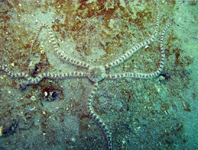Abstract
The identity of Azara’s No. 246 “Trepador remos y cola roxos” and the names Dendrocolaptes miniatus Illiger, 1820 and Dendrocopus rubricaudatus Vieillot, 1818, which are based on it, have never been convincingly elucidated, and previously proposed identifications in the literature are demonstrably incorrect. Azara shot his specimen in a Paraguayan forest and provided a detailed description and measurements of it in his Spanish text. These are sufficient to confirm the identity of the specimen and the names based on it as the Olive Spinetail, long known as Cranioleuca obsoleta (Reichenbach, 1853). Dendrocolaptes miniatus Illiger, 1820 and Dendrocopus rubricaudatus Vieillot, 1818 nevertheless have date priority over that name, but as they have not been used as valid since 1899 they are nomina oblita under Article 23.9.2 of the Code. Cranioleuca obsoleta has been in universal use for this species since Hellmayr (1925), so it qualifies as a nomen protectum under Article 23.9.2, and remains the valid name for the Olive Spinetail.
References
Azara, F. de (1802) Apuntamientos para la Historia Natural de los Páxaros del Paraguay y Río de la Plata. Tomo 1. Imprenta de la Viuda de Barra, Madrid, 562 pp.
Azara, F. de (1805a) Apuntamientos para la Historia Natural de los Páxaros del Paraguay y Río de la Plata. Tomo 2. Imprenta de la Viuda de Barra, Madrid, 562 pp.
Azara, F. de (1805b) Apuntamientos para la Historia Natural de los Páxaros del Paraguay y Río de la Plata. Tomo 3. Imprenta de la Viuda de Barra, Madrid, 562 pp.
Azara, F. de (1809) Voyages dans l´Amérique Méridionale. 3. Oiseaux. Dentu, Paris, 479 pp.
https://doi.org/10.5962/bhl.title.84598
Beddall, B.G. (1983) The isolated Spanish genius—Myth or reality? Félix de Azara and the birds of Paraguay. Journal of Historical Biology, 16, 225−258.
https://doi.org/10.1007/BF00124699
Berlepsch, H.von. (1887) Appendix systematisches verzeichniss in der Republik Paraguay bisher beobachteten vogelarten. Journal fur Ornithologie, 35, 113−134.
https://doi.org/10.1007/BF02006191
Bertoni, A.de.W. (1901) Aves nuevas del Paraguay. Continuación a Azara. Anales Científicos Paraguayos, 1, 1−216.
https://doi.org/10.5962/bhl.title.13398
Cabanis, J.L. & Heine, F. (1859) Verzeichniss der ornithologischen Sammlung des Oberamtmann Ferdinand Heine auf Gut St. Burchard vor Halberstadt, Mit kritischen Anmerkungen und Beschreibung der neuen Arten systematisch bearbeitet. Museum Ornithologicum Heineanum, 2, 1−176.
Cabrera, A. (1934) Los envíos de Félix de Azara al Real Gabinete de Historia Natural de Madrid. Anales de la Sociedad Española para el Progresso de las Ciencias, 1, 98–100.
Contreras, J.R. (2010) Félix de Azara. Su Vida y su época. tomo II. Calidad Gráfica, Zaragoza, 466 pp.
Hartlaub, C.J.G. (1847) Systematischer index zu Don Félix du Azara’s Apuntamientos para la Historia Natural de los Páxaros del Paraguay y Río de la Plata. Schünemann, Bremen, 29 pp.
Hellmayr, C.E. (1925) Catalogue of the birds of the Americas Part 4. Furnariidae—Dendrocolaptidae. Field Museum of Natural History Publication, 234, Zoological Series, 13, 1−390.
ICZN (International Commission on Zoological Nomenclature) (1999) International Code of Zoological Nomenclature. 4th Edition. The International Trust for Zoological Nomenclature, The Natural History Museum, London, 106 pp.
Illiger, J.K.W. (1820) in Lichtenstein, H. Die Gattung Dendrocolaptes. Abhandlungen Physikalische Klassen Koniglich-Preussischen Akademie der Wissenschaftliche zu Berlin, 1818−19, 197−210.
Koch, C.L. (1816) System der baierischen Zoologie. Die Säugthiere und Vögel Baierns. Zum Gebrauch als Taschenbuch. Vol. 1. Steinische Buchhandlung, Nürnberg, 435 pp.
https://doi.org/10.5962/bhl.title.50218
Lafresnaye, F. de (1840) Voyage dans l’Amérique Méridional (le Brésil, la République Argentine, la République Orientale de l’Uruguay, la Patagonie, la République du Chili, la République de Bolivia, la République du Pérou) exécuté pendant les années 1826, 1827, 1828, 1829, 1830, 1831, 1832 et 1833. Tome Quatrième Oiseaux. P. Bertrand, Paris, 395 pp.
Laubmann, A. (1939) Die Vögel von Paraguay. Band I. Strecker & Schröder Verlag, Stuttgart, 246 pp.
Pereyra, J.A. (1945) La Obra Ornitológica de Don Félix de Azara. Biblioteca Americana, Buenos Aires, 166 pp.
Reichenbach, L. (1853) Handbuch der Speciellen Ornithologie 9: Scansoriae, Klettervögel, Spechtvögel. Expedition der vollständigsten naturgeschichte. Dresden and Leipzig, 336 pp.
Sclater, P.L. (1890) Catalogue of the Passeriformes or Perching Birds in the Collection of the British Museum. Vol. 15. Tracheophonae or the Families Dendrocolaptidae, Formicariidae, Conopophagidae and Pteroptochidae. British Museum of Natural History, London, 371 pp.
Smith, P. (2017) The identity of Azara’s No. 315 “Ibiyau de cola extraña” and No. 316 “Ibiyau anónimo” (Aves: Caprimulgidae). Zootaxa, 4337 (4), 555−559.
https://doi.org/10.11646/zootaxa.4337.4.10
Smith, P. (2018a) Azara’s spinetails (Aves: Furnariidae). The identity of No. 236 Chiclí and No. 237 Cógogo. Bonn Zoological Bulletin, 67, 171−174.
Smith, P. (2018b) The identity of Sylvia ruficollis Vieillot, 1817 and Azara’s No. 240 “Cola aguda cola de canela obscura” (Aves; Furnariidae). Ardea, 106, 79−83.
https://doi.org/10.5253/arde.v106i1.a5
Smith, P. (2018c) The identity of the mysterious “Azara´s Parakeet” Sittace flaviventris Wagler, 1832. Anais da Academia Brasileira de Ciências, 90, 2851−2854.
https://doi.org/10.1590/0001-3765201820170881
Smith, P. (2018d) The identity of two of Azara’s “mystery” waterbirds. Caldasia, 40, 383−389.
https://doi.org/10.15446/caldasia.v40n2.69840
Smith, P. (2020) Azara’s no. 243 ‘Trepador de pico corto’ is a Lesser Woodcreeper Xiphorhynchus fuscus. Bulletin of the British Ornithologists Club 140: 47-51.
https://doi.org/10.25226/bboc.v140i1.2020.a5
Smith, P., Pacheco, J.F., Bencke, G.A. & Aleixo, A. (2018) Senior synonyms for three Neotropical birds described by Vieillot based on Azara (Passeriformes: Thraupidae, Tyrannidae, Tityridae). Zootaxa, 4433 (1), 141−150.
https://doi.org/10.11646/zootaxa.4433.1.8
Vieillot, J.L.P. (1818) Nouveau Dictionnaire d’Histoire Naturells, Appliquée aux Arts, à l’Agriculture, à l’Économie Rurale et Domestique, à la Médicine, etc. par una Société de Naturalistes et d’Agriculteurs. Nouvelle édition. Tome 26. Deterville, Paris, 584 pp.
Voss, R.S., Myers, P., Catzeflis, F., Carmignotto, A.P. & Barreiro, J. (2009) The six opossums of Félix de Azara: Identification, taxonomic history, neotype designations, and nomenclatural recommendations. Bulletin of the American Museum of Natural History, 331, 406–433.

